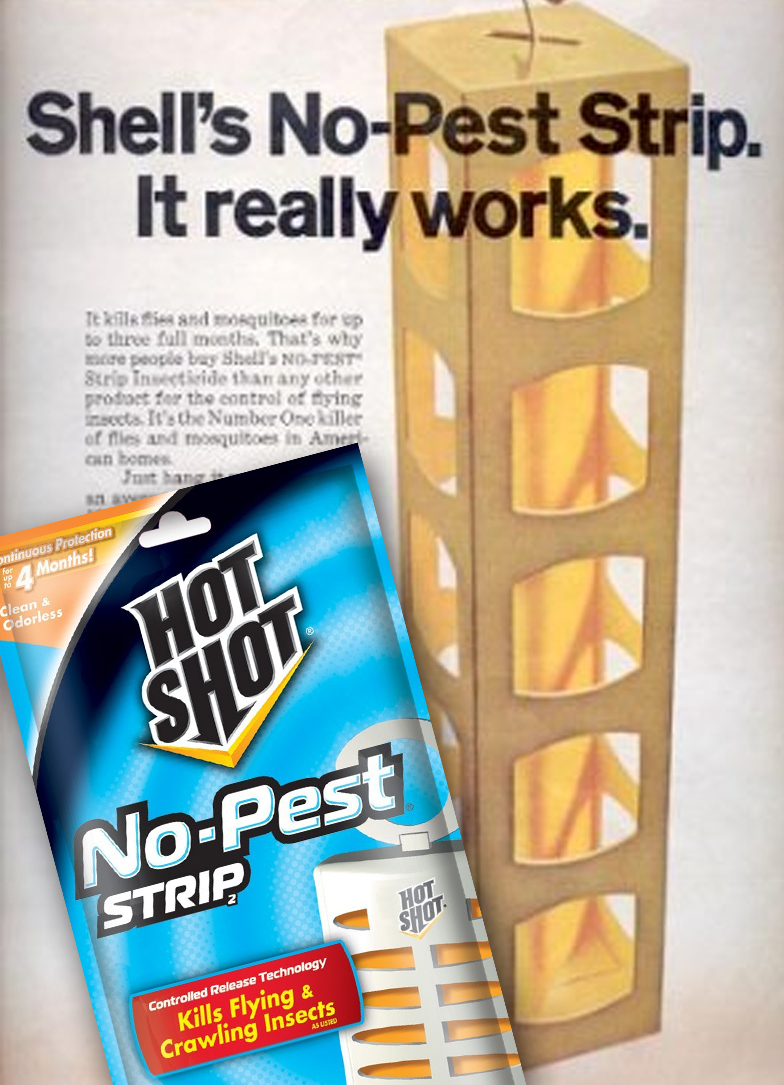
A 1970 Shell No-Pest strip ad and a current version of the plastic resin insecticide formulation still sold in stores.
With the growing incidence of bed bugs being found in homes and apartments, the potential for pesticide misuse is up. Evidence of the potential for harm came out last week in a report from the Centers for Disease Control’s Morbidity and Mortality Weekly Report (By the way, I’m absolutely sure that with its current title this periodical will never make Amazon.com’s Best Sellers in Magazines List).
The study reports on acute illnesses associated with dichlorvos is the active ingredient in no-pest strips. If you’ve been around awhile like me, you may remember the old “Shell No-Pest Strips” commonly advertised on television. Same product 50 years later.
The insecticide dichlorvos looked like it might have seen the last of its days a few years back, at least partly because of its acute toxicity to humans. It’s a holdover from the era of the old organophosphate insecticides (Dursban and diazinon, etc.) which are now off the market for a variety of reasons. But dichlorvos has a unique property: its relatively high volatility makes it useful as a fumigant. And thanks to its effectiveness against bed bugs, dichlorvos now appears to be staging a comeback.
It just so happens that the dichlorvos in no-pest strips kills bed bugs, even those that are resistant to most new insecticides. But it can also hurt you if it’s not used carefully as described in the label. The CDC study reports on 31 acute DDVP pest strip–related illness cases recorded from seven U.S. states and Canada from 2000 to 2013 (more cases undoubtedly occurred that were not part of this study). Most of the illnesses resulted from using the product in commonly occupied living areas (e.g., kitchens and bedrooms), in violation of label directions. According to the report, “Although 26 of the 31 cases involved mild health effects of short duration, five persons had moderate health effects.”
The report concludes that in order to prevent dichlorvos-related illnesses, everyone should be educated on correct use of pest strips, and how to control insect pests using safer pest control methods. I agree and will use the opportunity to remind anyone who’s listening that no one should ever use a pesticide without first reading and following the label directions exactly.
Some key label points to remember about no-pest strips containing dichlorvos:
- These strips are not for areas where you live or eat. They are ideal for use homes that sit vacant for four or more months, like a vacation home. But in an occupied home strips may only be used in closets, wardrobes and cupboards, storage units, garages, attics or crawl spaces. The rule of thumb is that these strips may only be used in areas occupied by people for less than four hours a day. If you use in a cabin or vacation home, and come back to stay overnight within four months of placing the unit, take the strip outside while you are there.
- Do not over-apply. One 65 gm strip 900-1,200 cubic feet. Need some math help? According to the label, one unit will treat a 10 ft x 13 ft room with an 8 ft ceiling for up to 4 months. A typical 6′ by 12′ by 8′ walk-in closet would be too small for one strip (only 575 cubic feet), and would be an over-application.
- Do not use in kitchens or food prep or storage areas where unwrapped food may be exposed. Kitchen utensils should never be allowed to contact the strips.
- Pets and children should not play or sleep where strips are in use.
According to the CDC report, most of the illnesses (65%) reported in the CDC paper occurred when exposures exceeded four hours per day. Illnesses included neurological, respiratory and gastrointestinal symptoms.
This is not to say these products don’t have a use. When my daughter discovered bed bugs in her bedroom and closet a couple of years ago, we used a dichlorvos strip in her closet, carefully following label directions. It gave her peace of mind, and probably killed a few nasty bed bugs. But make no mistake–this insecticide should be used with care.
Of course the rule about reading the dichlorvos label applies to all home insecticides. In another CDC report, injuries and illnesses related to use of total release foggers (“bug bombs”) were studied. Over a five year period, 466 injuries were documented. Fire hazards are one of the risks of using too many bug bombs in a home.
Insecticide labels are not only written for your safety, they are also legal documents. When you don’t follow the label directions (including the application rates, or where you use a pesticide) you could be stuck with a fine (or worse) for violating federal and state pesticide laws. The label is written for your benefit, to allow you to use a product safely and effectively. Let’s all take a few minutes to read and follow the label before using any pesticide.